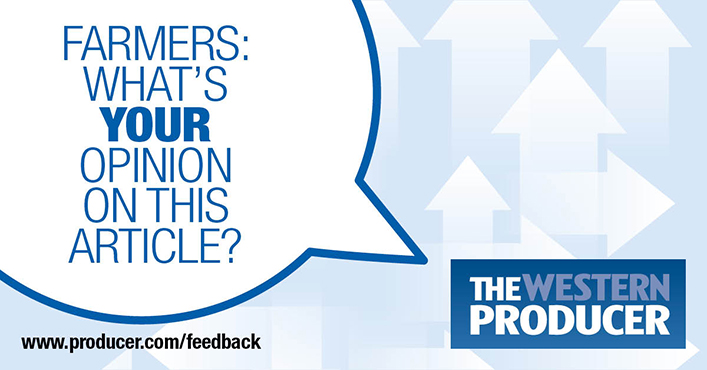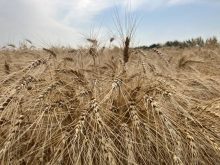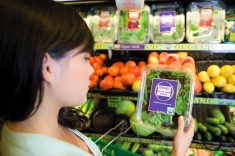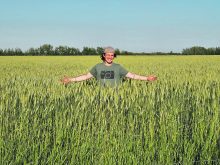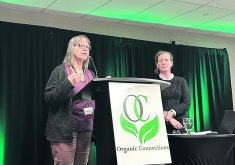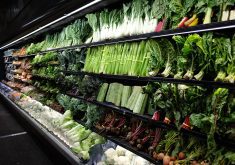A Manitoba producer finds a delicate balance to help him boost production while maintaining organic certification
Ile de Chenes, Man. — Three organic farmers swap fields back and forth, keeping land certified five years before returning to alfalfa.
Their rotation is a delicate balance, but worth the complexity.
For Ile de Chenes farmer John Gehrer, the payoff this fall has been significant for his low-input organic system, considering his management plan did not unfold as desired.
Gehrer explained the strategy to 40 farmers and agronomists at his field day Aug. 10.
His system requires two or three between-row cultivation passes.
This year he could not give his three main organic demo fields their full cultivation compliment. Even though the intended field passes did not happen, his cultivation-only fields got at least 87 percent cultivation on the first pass. The 87 percent figure comes from having rows on 22-inch centres with a 19-inch blade width.
Gehrer pointed out that all seeds are non-GM on any organic farm. Organic criteria require organic seed, if available, which it often is not within reasonable distance or the varieties he wants. In that case, certification allows non-organic, non-GM certified seeds be used for planting. The three demo fields included spring wheat, fababeans and hemp.
- Spring wheat yield was 60 bushels per acre. The organic wheat selling price is about $18 per bu., but this field is a transition field, which means it is treated as organic but crop produced cannot be sold as organic. In 2025, the field will be certified organic and then the crop grown can be sold at a higher organic price. Input costs were $36 per acre. That’s with wheat seed at $12 per bu., seeding three bushels per acre. Only one cultivation pass. Lots of lambs quarter. Herbicide savings were $30 per acre.
- Fababean yield was 25 bu. per acre at $19 per bu. Inputs were $66 per acre. That’s with fababean seed at $22 per bu., seeding three bushels per acre. Only one cultivation was done. Severe weeds were present. Herbicide saving $10 per acre.
- Hemp yield was 1,100 pounds per acre at $1.75 per lb. after cleaning cost is paid. Input costs were $48.40 per acre. That’s with hemp seed at $2.20 per lb., seeding 22 lb. per acre. Two cultivations. Field was very clean. Herbicide savings were $10 per acre.
Gehrer’s 1,000 acre farm is one-third organic. The remaining two-thirds are what he described as conventional-zero till, but with some non-GM crops for good measure. Prices for his organic crops range 50 percent to 75 percent higher than his conventional crops.
“I wasn’t chasing any kind of organic goal for the farm,” he said. “I just wanted to learn how to farm conventionally with less pesticides. That’s what got me into this. I use registered pesticides on my conventional crops. I seldom use insect and disease control applications in order not to harm beneficial insects.”
Gehrer told the audience that any land-sharing deal need livestock in the mix. Livestock provides a market for the necessary three-year alfalfa interlude required to clean up weeds, which always increase in annual crop organic production.
Plus livestock provides the necessary manure to grow organic crops.
In Gehrer’s situation, the other two partners are dairy producers, so they have a ready market for alfalfa. His farm is southeast of Winnipeg in a heavy dairy area, so there’s a demand for forages, as well as adequate manure.
“I usually start my five-year organic schedule with hemp or oats. Oats are thicker than barley or wheat, so oats are very competitive with weeds. Hemp grows very tall, so it also competes well with weeds. Five years is about the maximum time I can keep it clean enough in organic, then it has to go back into alfalfa.
“No chemicals can be used in taking out the alfalfa. We’ve found that we can plow to remove the alfalfa, then a cultivation in spring is effective in having little alfalfa left and have a good seedbed.
“We tried an alternative to plowing in 2022. We cultivated the alfalfa field twice in fall and then twice in spring. This was not enough to control the alfalfa effectively. After the hemp germinated, the alfalfa was still there and the field looked like an alfalfa field. With much effort, we were able to do inter-row cultivation. This double cultivation was enough to take out most alfalfa. The hemp grew over the alfalfa and the field looks very good now.”
As the tour drove past the three demo fields, Gehrer chuckled that the arrangement might seem awkward to many people.
“For example, look at that beautiful soybean crop on the right. That’s my land. I wish it was my crop. I sometimes don’t get to farm my own fields for eight or nine years in this system. But that’s OK. It works.
“Once the inspector approves a new alfalfa crop, it’s kept in alfalfa three years. After that, it goes into organic production. It’s typically certified for organic annual crops up to five years. The entire rotation is driven solely by the need to keep higher profit organic crops growing for each of the three partners every year.
“Let’s look at three fields that demonstrate the importance of correctly timed cultivation between the rows. We successfully cultivated the hemp twice, but then were too lazy to do it in the wheat and fababeans. We don’t mind a few other plants growing. I consider these weeds as intercrop. This year, some weeds got a bit out of hand in the fields that have been in annual crops for too long.”
Spring wheat — Gehrer said he was ready to do the second cultivation when, in his words, “I thought better of it and took July off for an e-bicycle trip to Ottawa. That’s when weeds took over. If I’d done the second passes, we would not have had a weed problem and would have gotten more than 60 bu. My other conventional wheat fields yielded 85 bu.
“We had been so focused on the hemp fields. By the time that cultivation was done, it had become just too much, so we left it and went away. Organic farming takes a lot more effort. I’m showing you this wheat field as an example of what not to do.”
University of Manitoba plant scientist Martin Entz told the group that lambs quarter in wheat isn’t the big problem it appears to be.
“It depends on what kinds of weeds you have. Weeds are either seed-limited or not seed-limited,” said Entz.
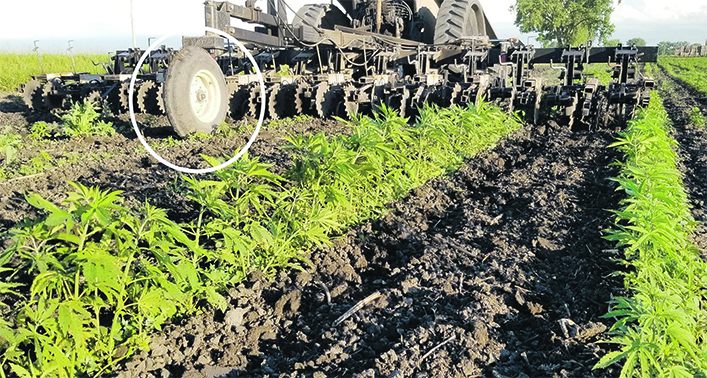
“Lamb’s quarter already has a lot of seeds in the soil. Adding more seeds doesn’t matter. These are non-seed-limiting weeds, along with weeds like redroot pigweed and mustard.
“Wild oats, on the other hand is what we call a seed-limited weed. We do not want wild oats going to seed. Due to continuous cropping, the type of wild oats we have now are not very dormant in the soil. Wild oats in an organic system is a real challenge. You want to get on top of it right away.”
Entz said wide-row spacing such as 22 inches may not be the best way to manage weeds in organic fields on Red River clay soils.
He said a better idea is to use narrow row spacing with high seeding rates to snuff weeds within the seed row. However, narrow row makes between-row cultivation more difficult and increases the risk of hurting your crop. Instead of 22 inches, Entz said 12-inch row spacing is a good compromise.
Mario Tenuta, University of Manitoba fertility specialist, said soil phosphorus tests on Gehrer fields had skyrocketed in the past few years because of manure.
“P (phosphorus) levels in those manures are much higher relative to what crops require relative to N (nitrogen). The phosphorus-to-nitrogen ratio of the manures are much higher than the phosphorus-to-nitrogen ratio used by crops. Thus phosphorus levels shoot up. They are currently at levels considered excessive. It requires holding off phosphorus application for many years to bring soil test phosphorus down. This is a common issue in year-on-year manured soils.”
Fababeans — Gehrer said this was the dirtiest looking field, with volunteer crops dating back many growing seasons. Fababeans also appeared to have a disease, which aborted seed production. He said this was a small field intended to learn which legume crops could do well in an organic system.
“I was hoping the fababeans would outgrow the weeds and grow 1.8 metres tall to shade out late weeds. This did not happen and now the weeds are competitive with the fababeans so yield will be low.”
He plans to swath so the weeds dry out, harvest the crop then chisel plow and turn it back to one of his dairy partners in 2024 to begin the mandatory three-year detox stint in alfalfa.
“Once the crop is dry, the weeds and volunteers will be dry and won’t be an issue to a buyer. I might sell the organic fababeans as is, without running through a cleaner. Organic fababeans are worth nearly double what conventional fababeans are worth. They’re huge right now.”
Entz said, “the plant population was too low to beat out the volunteer crop from previous years. His old planter was not capable of putting down enough of those large seeds.”
Hemp — The third demo field had been in its third year of its alfalfa cycle in 2022 and had received dairy manure during that cycle, so it was prime for a good crop in 2023 when Gehrer seeded it to organic hemp.
With good nutrition already in the soil, the hemp germinated and grew fast to out-compete the few weeds. The two between-row passes were made before the hemp was a foot high. The cultivator took out nearly all volunteer alfalfa.
Judging by the crop appearance, Gehrer figured this field would give him about 1,200 lb. per acre, which is about double the normal yield for organic hemp.
However, his other 2023 organic hemp fields are expected to yield only 600 lb. These two fields are a couple years removed from the alfalfa stage.





